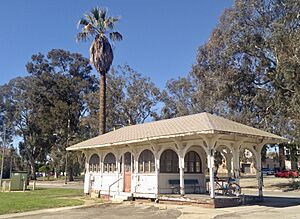Westgate Line facts for kids
Quick facts for kids Westgate |
|
|---|---|
 |
|
| Overview | |
| Owner | Southern Pacific Railroad |
| Locale | Los Angeles |
| Termini | Pacific Electric Building Santa Monica, California |
| Stations | 18 |
| Service | |
| Type | Interurban |
| System | Pacific Electric |
| Operator(s) | Pacific Electric |
| Ridership | 263,017 (1926) |
| History | |
| Opened | 1906 |
| Closed | November 18, 1940 |
| Technical | |
| Track gauge | 1,435 mm (4 ft 8 1⁄2 in) standard gauge |
| Old gauge | narrow gauge |
| Electrification | Overhead line, 600 V DC |
The Westgate Line was a special train route in Los Angeles that ran from 1911 to 1940. It was like a big electric streetcar line that connected Downtown Los Angeles all the way to Santa Monica. This line was one of four routes that linked these two places without going through Hollywood.
What made the Westgate Line interesting was its winding path, especially near Pacific Palisades. This route was chosen to encourage new homes to be built in that area. Many people who rode this line were veterans and workers from the Soldiers' Home in Sawtelle. They would often stop at the Streetcar Depot, West Los Angeles.
Contents
History of the Westgate Line
The Westgate Line started running in 1906. It was first built by a company called the Los Angeles Pacific Railroad. At first, the tracks were "narrow gauge," meaning they were closer together than standard tracks.
On March 19, 1906, a big change happened. Another company, Henry Huntington’s Pacific Electric Railway, bought all the Los Angeles Pacific Railroad lines. This cost $6 million, which would be a lot more money today!
After the purchase, the line was updated. In early 1908, the tracks were changed to "standard gauge." This made them the same width as most other train tracks.
The Westgate Line continued to serve passengers for many years. However, by July 1, 1940, service was greatly reduced. The line was completely stopped on November 18, 1940.
The Westgate Line Route
The Westgate Line shared part of its path with another line called the Sawtelle Line. They both went as far as Sawtelle. From Sawtelle, the Westgate Line turned northwest onto its own special path.
This path was like a private road, not a public street. It had two tracks running down the middle. The line crossed Ohio Avenue and then ran along the edge of the U.S. Government Soldier's Home property.
The tracks then went into the Soldier's Home grounds. They continued northwest, crossing Wilshire Boulevard. After that, they entered another private path in the middle of San Vicente Boulevard.
The two tracks followed San Vicente Boulevard in a big curve to the west. They ran between two roadways, leaving the Soldier's Home property at Bringham Avenue. The tracks continued west, crossing streets like Barrington and Montana Avenues, and Bundy Drive.
Finally, the line reached the city limit of Santa Monica at 26th Street. Once in Santa Monica, the tracks continued for about 2 miles (3.2 km) southwest. They crossed many numbered streets to reach Ocean Avenue. From there, the tracks ran southeast on Ocean Avenue, crossing major intersections like Montana Avenue and Wilshire Boulevard. The line ended one block farther south at Broadway.
How Many People Rode the Line?
The Westgate Line was quite busy, especially in its early years. For example, in 1913, over 394,000 passengers rode the line! This shows how important these electric trains were for getting around Los Angeles and Santa Monica back then. Even in 1926, over 263,000 people used the line.
See also
- Streetcar suburb
- Streetcars in North America
- List of California railroads
- History of rail transportation in California
References
![]() This article incorporates text from a free content work. Licensed under the public domain as a work of the State of California. License statement/permission on Wikimedia Commons. Text taken from 1981 Inventory of Pacific Electric Routes, California Department of Transportation, Los Angeles County Metropolitan Transportation Authority.
This article incorporates text from a free content work. Licensed under the public domain as a work of the State of California. License statement/permission on Wikimedia Commons. Text taken from 1981 Inventory of Pacific Electric Routes, California Department of Transportation, Los Angeles County Metropolitan Transportation Authority.

